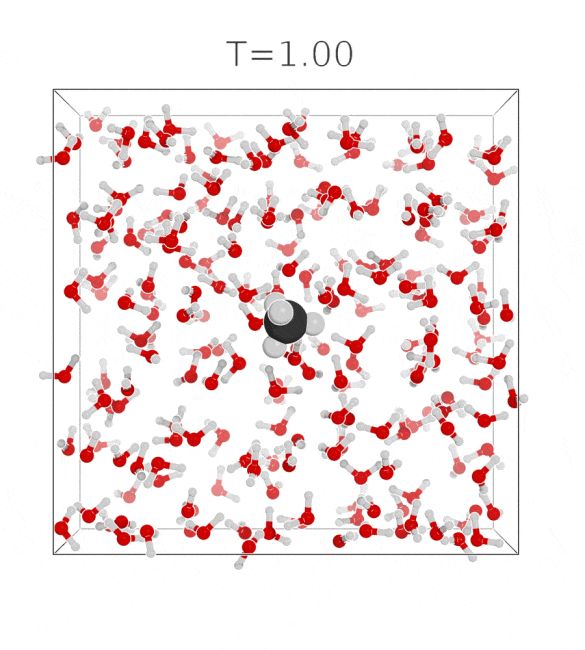
🚀 After two+ years of intense research, we’re thrilled to introduce Skala — a scalable deep learning density functional that hits chemical accuracy on atomization energies and matches hybrid-level accuracy on main group chemistry — all at the cost of semi-local DFT ⚛️🔥🧪🧬
18.06.2025 11:24 — 👍 72 🔁 25 💬 3 📌 7

Finally, we also look at what happens if we predict the hydration free energy of methane using the potential that was trained on water (and vice versa). (10/10)
17.12.2024 12:32 — 👍 0 🔁 0 💬 1 📌 0

The approach is tested on the estimation of hydration free energies of rigid water and methane (LJ + Coulomb interactions). We find good agreement with experimental reference values. (9/n)
17.12.2024 12:32 — 👍 0 🔁 0 💬 1 📌 0

Target Score Matching
Denoising Score Matching estimates the score of a noised version of a target distribution by minimizing a regression loss and is widely used to train the popular class of Denoising Diffusion Models. A...
We then parametrize the interpolating potential with a neural network and train it to be the equilibrium potential corresponding to the samples.
Since the endpoint Hamiltonians are also available, we do this with target score matching. (8/n)
arxiv.org/abs/2402.08667
17.12.2024 12:32 — 👍 0 🔁 0 💬 1 📌 0

In this work, we go the other way around, and define the interpolation by the sampling process of the intermediate densities. (6/n)
17.12.2024 12:32 — 👍 0 🔁 0 💬 1 📌 0
For TI, this means that we are free to choose one way of describing this interpolation, and the hard part is getting the other one. Usually one chooses the interpolation of potentials and performs simulations at a sequence of intermediate potentials to obtain samples. (5/n)
17.12.2024 12:32 — 👍 0 🔁 0 💬 1 📌 0
Note that (1) and (2) define the same object, a one-parameter family of probability densities interpolating between the endpoint Boltzmann distributions. (4/n)
17.12.2024 12:32 — 👍 0 🔁 0 💬 1 📌 0
Thus, to numerically estimate the free-energy difference, two things are necessary: (1) an interpolating family of potentials and (2) samples from the Boltzmann densities of the intermediate potentials to estimate the expectation value in the integrand. (3/n)
17.12.2024 12:32 — 👍 0 🔁 0 💬 1 📌 0

Thermodynamic Integration (TI) computes the free energy difference between two potentials as an integral over a coupling variable parametrising an interpolation between the two potentials. (2/n)
17.12.2024 12:32 — 👍 0 🔁 0 💬 1 📌 0

hello bluesky! we have a new preprint on solvation free energies:
tl;dr: We define an interpolating density by its sampling process, and learn the corresponding equilibrium potential with score matching. arxiv.org/abs/2410.15815
with @francois.fleuret.org and @tbereau.bsky.social
(1/n)
17.12.2024 12:32 — 👍 34 🔁 11 💬 1 📌 1
Senior Researcher @ Microsoft Research AI for Science
Bestuurslid @kwakzalverij.nl
Rabbit fan
Lost quantum chemist working in AI
Views are my own and do not necessarily reflect those of my employer!
AI4science research, density functional theory @ Microsoft Research Amsterdam. PhD on generative modeling, flows, diffusion @ Mila Montreal
Ph.D. Student at @Mila_Quebec / @mcgillu
• ML, Physics, Math • Science Comms Enthusiast. Former intern
@MSFTResearch AI4Science
With the Alan Turing Institute • 📚 Formerly MSFT Research Ams, Cambridge MLG • GitHub: wesselb
Microsoft Research AI for Science, previously physics @ Cambridge. views my own
Computational chemistry & physics, electrons, deep learning 🚲☕️♟️ Microsoft Research AI for Science · https://jan.hermann.name
ELLIS & IMPRS-IS PhD Student at the University of Tübingen.
Excited about uncertainty quantification, weight spaces, and deep learning theory.
PhD student at University of Cambridge. Intern at FAIR, Meta & Prescient Design, Genentech. Deep Learning for Biomolecule Design.
https://chaitjo.com
The Erwin Schrödinger International Institute is a visitors-oriented research institute for mathematics and physics at the University of Vienna @univie.ac.at
www.esi.ac.at
We perform research in theoretical chemistry, specifically classical and quantum statistical mechanics, mathematical approaches, and machine learning methods applied to condensed phases.
Assistant Professor at Mila and UdeM
https://necludov.github.io/
(He/they) Physicist. ML scientist. PhD in geometric deep learning. 🏳️🌈🏳️⚧️
Riniker research group, ETH Zurich
Incoming Assistant Professor @Imperial College London. Post-doc @UniofOxford. Into Geometry ∩ Generative Models. @mila-quebec.bsky.social Affiliate member. Phd from @mila-quebec.bsky.social / McGill.
website: https://joeybose.github.io/
Research Scientist @IsomorphicLabs. Previously @GoogleDeepMind. Core developer of #GraphCast. He/him. Physics, ML & drug discovery. Opinions are my own.
Research Scientist @ NEC Labs Europe, Ph.D. in Theoretical Chemistry @ SimTech & @unistuttgart.bsky.social, ML/DL for Chemistry & Materials Science
AI Scientist at Xaira Therapeutics & PhD student at Mila
PhD student at École Polytechnique and École Normale Supérieure - Generative models and Monte Carlo methods
FAIR Chemistry. Simulation-based Inference.







